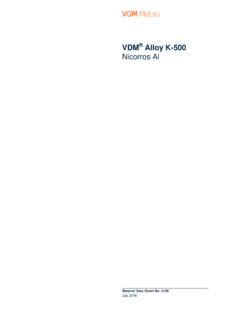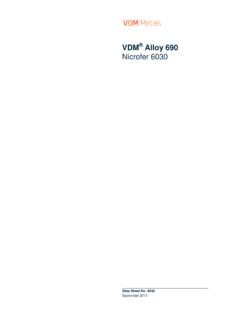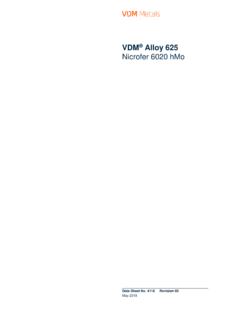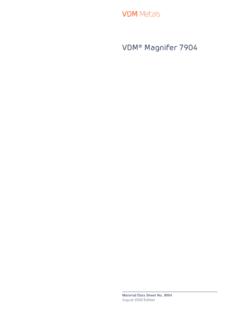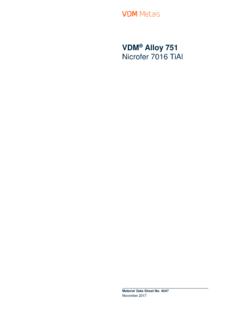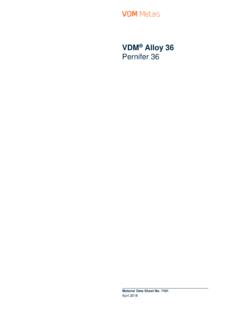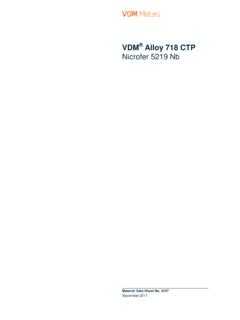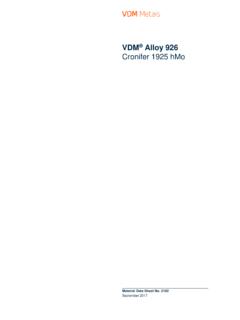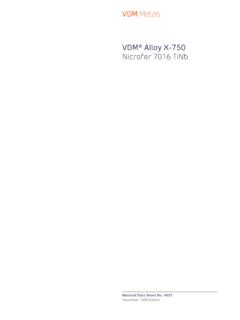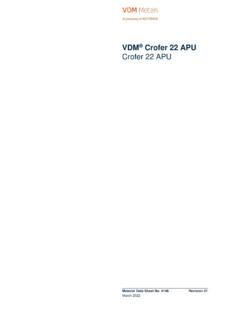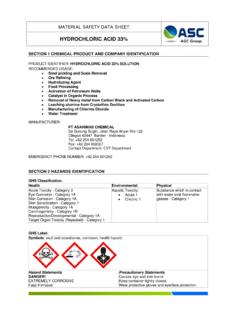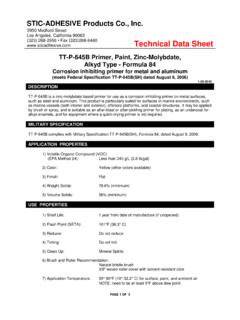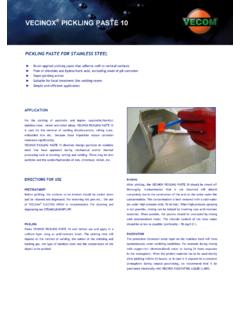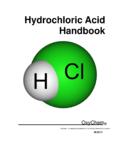Transcription of VDM Alloy 33 Nicrofer 3033
1 VDM Alloy 33 Nicrofer 3033 material data sheet No. 4142 January 2018 January 2018 VDM Alloy 33 2 VDM Alloy 33 is an austenitic Alloy that has an excellent resistance against common corrosion and pitting corrosion in media containing chloride due to its well-balanced analysis and extraordinarily high chrome concentration. Also because of its very high strength and good workability, VDM Alloy 33 is a material that can be used for many applications in the chemical processing industry. VDM Alloy 33 is characterized by: excellent resistance against pitting corrosion in media containing chloride and against general corrosion in hot mineral acids, mixed acids and alkalis as well as seawater and brackish water, high strength and high ductility even in high temperatures, good workability and welding characteristics, ASME approval for pressure vessels in the temperature range from -196 C to 450 C (-320 to 842 F).
2 Designations Designation material name EN X1 CrNiMoCuN33-32-1 UNS R20033 Standards Product form DIN VdT V ASTM ASME others Plate and sheet EN 10029 516 B 625 SB 625 SEW 400 Strip 516 B 625 SB 625 SEW 400 Rod 516 B 649 SB 649 Wire: Only used as welding wire VDM FM 33 Table 1 Designations and standards VDM Alloy 33 Nicrofer 3033 January 2018 VDM Alloy 33 3 Chemical composition Ni Cr Fe C S N Mn Si Mo Cu P Min. 30,0 31,0 Bal. 0,35 0,5 0,3 Max. 33,0 35,0 0,015 0,010 0,6 2,0 0,5 2,0 1,2 0,02 For technical reasons this Alloy may contain more elements then listed. Table 2 Typical chemical composition (%) Physical properties Density Melting range Relative magnetic permeability at 20 C (68 F) 7,9 g/cm at 20 C 493 lb/ft3 at 68 F C ( 2,430 2,498 F) 1,01 Temperature Specific heat capacity Thermal conductivity Electrical resistivity Modulus of elasticity Coefficient of thermal ex-pansion C F Jkg K Btulb F Wm K Btu insq.
3 Ft h F cm GPa 106 ksi 10-6K 10-6 F 20 68 4461) 104 195 100 212 466 107 185 200 392 486 109 176 300 572 503 112 170 400 762 520 114 163 500 932 538 116 159 1) at 25 C (77 F) Table 3 Typical physical properties at room and elevated temperatures January 2018 VDM Alloy 33 4 Microstructural properties VDM Alloy 33 has a cubic face-centered crystal structure. The content of approx. nitrogen together with 31% nickel stabilizes the austenitic crystal structure and reduces the dispersion speed of intermetallic phases. Mechanical properties The following minimum values at room and increased temperatures apply to VDM Alloy 33 in the solution-annealed condition for longitudinal and traverse test samples of the specified dimensions.
4 The properties for other dimensions must be agreed separately. Temperature Yield strength Rp Yield strength Rp 1,0 Tensile strength Rm Elongation A C F MPa ksi MPa ksi MPa ksi % 20 68 380 420 720-920 104-133 40 100 212 320 350 200 392 270 300 300 572 240 270 400 752 220 250 500 932 210 240 Table 4 Mechanical properties at room and elevated temperature. Minimum values according to T V material data sheet 516 Product-form Dimensions Yield stress Rp 0,2 Yield stress Rp 1,0 Tensile strength Rm Elongation at fracture A mm in MPa ksi MPa ksi MPa ksi % sheet 50 380 420 720-920 104-133 40 Bar 150 380 420 720-920 104-133 40 Table 5 Mechanical properties at room temperature according to ASTM B 625 (strip, sheet ), B 649 (rod, wire) January 2018 VDM Alloy 33 5 ISO-V notch impact value ISO-V impact strength Ak (mean value) in J/m ISO-V notch impact energy Kv in J sheet 188 150 J (111 ft* lbf)
5 Bar/ forging 150 120 J Table 6- V-Probe according to DIN EN 10045-1 at 20 C (68 F) mean value of three samples longitudinal/transverse Hardness of Brinell HBW Brinell hardness 240 For sheet 50 mm ( in), strip 3 mm ( in), rod 150 mm ( in) January 2018 VDM Alloy 33 6 Corrosion resistance The austenitic material VDM Alloy 33 has an extremely high chrome concentration of 33% and therefore offers the basis for the excellent corrosion resistance in oxidizing media. The low addition of molybdenum and copper improves resistance in phosphorus acid and simplifies passivation in sulfuric acid. Besides the excellent resistance against nitric acid/hydro-fluoric acid mixture, the material also has great corrosion resistance against all alkali media.
6 Furthermore, the resistance against pitting corrosion in media containing chloride is also excellent. Optimal corrosion resistance can only be assured if the material is used in clean, metallic bright condition. Medium Temperature in C ( F) Corrosion rate in (mm/a) (inch/a) H2SO4 98% 100 (212) 0,04 ( ) 150 (302) 0,08 ( ) 200 (392) 0,04 ( ) H3PO4 85% 100 (212) 0,08** ( ) 154 ( ) 1,07 ( ) NaOH 25% 75 (167) < 0,01 ( ) 104 (boiling) ( ) < 0,01 ( ) 50% 75 (167) < 0,01 ( ) 100 (212) < 0,01 ( ) 156 (boiling) ( ) < 0,01 ( ) HNO3 12% 90 (194) < 0,01 ( ) HNO3 12% + HF 0,9% 0,24 ( ) HNO3 12% + HF 3,5% 1,19 ( ) HNO3 32% + HF 0,4% 0,27 ( ) HNO3 45% + HF 0,4% 0,67 ( ) HNO3 56% + HF 0,4% 1,66 ( ) HNO3 68% + HF 0,4% 3,08 ( ) ** Testing time.
7 7 days (0,2mm/a after one day// in/a) Table 7 Corrosion rate of VDM Alloy 33 in different media depending on concentration and temperature January 2018 VDM Alloy 33 7 Applications Typical applications for VDM Alloy 33 are: Heat recovery and distribution systems in the sulfuric acid production Pipes and heat exchangers for sulfuric acids contaminated with chlorides Vessels for storage and transport of nitric acid/hydrofluoric acid mixtures Seawater conducting pipes, condensers, coolers, etc. with excellent resistance against pitting corrosion Production and use of NaOH and KOH up to 70 and max. 170 C (338 F) Urea solutions in the concentration range from 5 to 90 Components for the pulp and paper industry Vessels and pipes in purified terephthalic acid (PTA) plants January 2018 VDM Alloy 33 8 Fabrication and heat treatment VDM Alloy 33 is ideally suited for processing by means of common industrial processing techniques.
8 Heating It is important that the workpieces are clean and free of any contaminants before and during heat treatment. Sulfur, phos-phorus, lead and other low-melting point metals can cause damage during the heat treatment of VDM Alloy 33. This type of contamination is also contained in marking and temperature-indicating paints or pens, and also in lubricating greases, oils, fuels and similar materials. The sulfur content of fuels must be as low as possible. Natural gas should contain less than of sulfur. Heating oil with a maximum sulfur content of is also suitable. Electric furnaces are preferable because of the precise temperature control and lack of contaminants from fuels.
9 The furnace temperature should be set between neutral and slightly oxidizing and it should not change between oxidizing and reducing. The work-pieces must not come in direct contact with flames. Hot forming VDM Alloy 33 should be hot-formed in a temperature range between 1,200 and 1,000 C (2,192-1,832 F) with subse-quent rapid cooling down in water or air. For heating up, workpieces should be placed in a furnace that is already heated up to the target value. Heat treatment after hot forming is urgently recommended for achieving optimal corrosion behavior. Cold forming The workpieces should be in the annealed condition for cold forming. VDM Alloy 33 has a higher work hardening than other austenitic stainless steels.
10 This must be taken into account in the design and selection of forming tools and equip-ment, and in the planning of forming processes. Intermediate annealing is necessary for heavy-duty cold forming work. For cold forming of > 15%, a final solution annealing must be conducted. Heat treatment Solution annealing should take place at temperatures between 1,100 and 1,150 C (2,012-2,102 F), preferably at 1,120 C (2,048 F). The retention time during annealing depends on the semi-finished product thickness and it can be calculated as follows: For thicknesses d < 10 mm ( in), the retention time is t = d 3 min/mm For thicknesses d = 10 to 20 mm ( in), the retention time t = 30 min + (d 10 mm) 2 min/mm For thicknesses d > 20 mm ( ), the retention time t = 50 min + (d 20 mm) 1 min/mm The retention time commences with the temperature equalization of the workpiece; longer times are generally considera-bly less critical than retention times that are too short.
